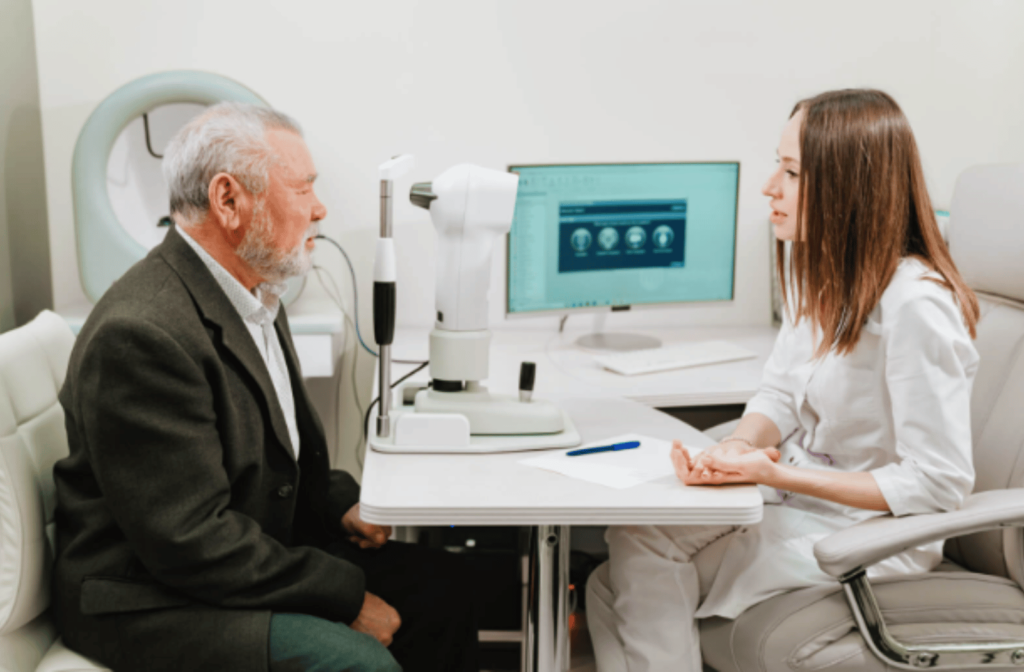You go to your eye exams expecting to address changes in your vision, get an updated glasses prescription, and shop some new frames. But occasionally, if you’re having underlying health issues, an eye exam can be another tool to help detect disease or medical conditions.
Eye exams allow your optometrist to see your blood vessels, nerves, and connective tissue through close-up exams of the surface of the eyes, retina, and optic nerve.
If health issues exist, your eyes can relay indicators of more than just vision problems. They can be a window into your body to help identify changes in your general health.
High Blood Pressure
The eye is full of blood vessels in the back of the eye, and in some instances, they can tell your optometrist about high blood pressure. Unusual bleeding or vessel breaks in the white of the eyes can be one of many indicators of high blood pressure.
High blood pressure can also be a risk factor for eye diseases such as glaucoma. If your family doctor is concerned with your blood pressure, keeping a regular eye exam schedule can help keep your eyes healthy.
Multiple Sclerosis
Multiple sclerosis (MS) is an autoimmune disease in which your body begins attacking nerve fibres, causing inflammation. The optic nerve is one of many sites in your nervous system that can indicate an autoimmune issue like MS.
During a regular eye exam, your optometrist assesses the health of your optic nerve. A healthy optic nerve has visible nerve fibres and blood vessels. Damage to the optic nerve can make it appear colourless.
Your optic nerve sends messages to your brain about what you’re seeing. Eye exams are critical in spotting damage to the optic nerve from MS-related inflammation, which can often lead to painful eye movement and blurred vision.
Thyroid Disease
Your thyroid gland secrets a delicate balance of hormones to control your metabolism. An overactive thyroid, or hyperthyroidism, can sometimes present in the eye. Protruding eyeballs and retracting eyelids (where the upper and lower lids can’t cover the surface of the eye) are indicators of an overactive thyroid, commonly brought on by Graves’ Disease.
Dry eye or blurry vision can sometimes emerge with hyperthyroidism. If you have a thyroid problem, regular eye exams can help monitor the symptoms present in the eyes.
Certain Types of Cancer
Skin cancers such as basal cell, squamous cell, and melanoma can often appear on the delicate skin of the eyelid. Your optometrist can sometimes also identify signs of lymphoma if it affects the inside of the eye—areas such as the iris and muscle fibres around the lens. Occasionally, tumours in other areas of the body can spread to the eye structures and can sometimes be seen in an eye exam.
During a routine eye exam, your optometrist will inspect the eyelids, surface of the eye, and interior aspect of the eye to assess eye health beyond common eye diseases.
Diabetes
Diabetes is a stealthy disease, and the symptoms in your eyes can come on when you least expect it. Optometrists can sometimes identify microaneurysms, swollen blood vessels, and dilated capillaries blocking blood flow to the eye and causing cloudy white spots on the retina.
If you suspect you may have symptoms of diabetes or are already diagnosed by your family doctor, diabetic eye exams and treatment can help catch symptoms of diabetic retinopathy and help you avoid vision loss.

Heart Disease
As the blood from your heart makes its way to your eye, optometrists can detect cardiovascular conditions such as clogged arteries and plaque deposits through an eye exam. Optical coherence tomography imaging is helping optometrists find evidence of heart disease in the eye by identifying microscopic marks left by eye strokes.
Healthy eyes of healthy people can also have these marks, so it’s not a foolproof diagnostic tool. However, if you already have heart disease, keeping on top of your eye exams can help optometrists monitor your optic nerve, blood vessels, and eye pressure.
Rheumatoid Arthritis
Most people associate arthritis with joint inflammation, but it can target your eyes, too. Signs of rheumatoid arthritis (RA) in your eyes is the presence of scleritis, which is inflammation of the white outer layer of the eye. RA, like many other inflammatory conditions, affects collagen production, which is the composition of the sclera. The resulting symptoms include deep eye pain and dry eye.
Regular eye exams can help your optometrist identify scleritis and work to discover the reason it’s developed. During eye exams, your optometrist can monitor and treat the symptoms of RA in your ocular structure alongside your family doctor or rheumatologist.
Book Your Annual Eye Exam with Henderson Vision Centre
If you have specific eye health concerns or want a comprehensive eye exam when your vision changes, book an appointment with Henderson Vision Centre’s team of optometrists. A thorough eye exam can keep your eyes healthy, detect eye diseases, and treat other conditions that affect your vision quality or cause ocular problems.



